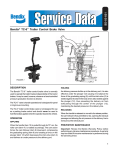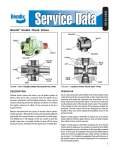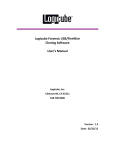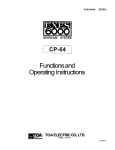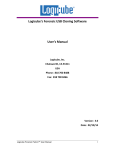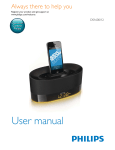Download BENDIX BW1576 User's Manual
Transcript
SD-03-3410 ® Bendix® VM-3™ Firewall Manifold DESCRIPTION NO.3 The VM-3™ is a control manifold serving as a manifold unit for air passages between cab and engine compartment and housing a double check valve and PR-4™ pressure protection valve. NO.9 NO.2 NO.4 NO.8 OPERATION 1. The double check valve receives supply air from the rear (primary) supply system, through port No. 3 on Fig. 1, and front (secondary) supply system, through port No. 1 on Fig. 1, and delivers whichever is higher in pressure to the spring brake system and through another port to the trailer supply through the dash mounted PP-7™ tractor protection control valve. 2. The PR-4™ pressure protection valve receives supply air from the front (secondary) supply port and supplies protected air to three ports, one on the engine side and two on the cab side. The PR-4™ valve will deliver air to these ports only after the front supply system has built up to at least 60 psi. NO.1 NO.7 WARNING! PLEASE READ AND FOLLOW THESE INSTRUCTIONS TO AVOID PERSONAL INJURY OR DEATH: 3. 4. 5. When working on or around a vehicle, the following general precautions should be observed at all times. 1. Park the vehicle on a level surface, apply the parking brakes, and always block the wheels. Always wear safety glasses. 2. Stop the engine and remove ignition key when working under or around the vehicle. When working in the engine compartment, the engine should be shut off and the ignition key should be NO.5 FIGURE 1 - ENGINE SIDE 3. Supply air for the trailer control hand valve is taken from a port inside the cab supplied from the rear (primary) air supply. The location and function of the various ports are shown in Fig. 1 for the engine side of the VM-3™ manifold and in Fig. 2 for the cab side. The chart shown on Fig. 1 explains the purpose and function of each port on the engine side and the chart shown on Fig. 2 the cab side. NO.6 6. 7. removed. Where circumstances require that the engine be in operation, EXTREME CAUTION should be used to prevent personal injury resulting from contact with moving, rotating, leaking, heated or electrically charged components. Do not attempt to install, remove, disassemble or assemble a component until you have read and thoroughly understand the recommended procedures. Use only the proper tools and observe all precautions pertaining to use of those tools. If the work is being performed on the vehicle’s air brake system, or any auxiliary pressurized air systems, make certain to drain the air pressure from all reservoirs before beginning ANY work on the vehicle. If the vehicle is equipped with an AD-IS™ air dryer system or a dryer reservoir module, be sure to drain the purge reservoir. Following the vehicle manufacturer’s recommended procedures, deactivate the electrical system in a manner that safely removes all electrical power from the vehicle. Never exceed manufacturer’s recommended pressures. Never connect or disconnect a hose or line containing pressure; it may whip. Never remove a component or plug unless you are certain all system pressure has been depleted. 1 1 NO.3 2 3 4 NO.9 5 NO.2 NO.4 NO.8 6 7 10 11 8 NO.1 NO.7 9 NO.6 NO.5 ENGINE SIDE FIGURE 1 Port No. 1 2 3 4 5 Diff. Lock Blk. 6 Trl. Sup. Yel. 7 (None) 8 2 Ident. on Casting Frt. Sup. Blue Park Sup. Red Rear Sup. Green Rad. Fan Blk. Air Rest. Blk. 9 Prk. Del. Red 10 Spg. Brk. Rest. - Grn. 12 Function Supply from No. 2 circuit reservoir. Delivers air from double check valve area to spring brake relay valve (R-8). Supply from No. 1 circuit reservoir. CAB BULKHEAD SIDE FIGURE 2 Port No. 1 2 3 4 Delivers protected air supply from PR-4 valve. Suggested use - air operated fan clutch. Connects directly to port No. 9 (Fig. 2) in cab. Suggested use - manifold connection to differential lockout mechanism. This is a 900 pass-through passage. Connects directly to port No. 10 in cab. Suggested use - deliver air from trailer supply valve (such as BW PP-7) to trailer. This is a 90° pass-through passage. Connects directly to port No. 11 in cab. Suggested use - any auxiliary manifold function. This is a straight through passage. Connects directly to port No. 12 in cab. Suggested use - air cleaner restriction gauge. This is a straight through passage. Connects directly to port No. 8 (Fig. 2) in cab. Suggested use - deliver air from park control valve to spring brake control valve (SR-1™ valve). This is a straight-through passage. Connects to secondary circuit reservoir and to port No. 4 (Fig. 2) in cab. Suggested use - supplies secondary reservoir air to the balance port of the SR-1 spring brake control valve. 5 6 7 Ident. on Casting Frt. Gauge Blue Prk. Sup. Red Rear Gauge Green Hand Brake Supply Green Access Blk. Access Blk. Trl. Sup. Red 8 Prk. Del. Red 9 Diff. Lock 10 Trl. Del. 11 (None) 12 Air Rest. Blk. Function Connects to gauge for No. 2 circuit reservoir. Supplies air from double check valve to park control valve. Connects to gauge for No. 1 circuit reservoir. Supplies air from No. 2 circuit reservoir to trailer hand control valve in cab. Connects with No. 10 on engine side. Supplies protected air from PR-4™ valve to any accessory control in cab. Supplies protected air from PR-4™ valve to any accessory control in cab. Supplies air from double check valve to trailer supply valve (tractor protection). Receives air from delivery of park control valve to deliver to SR-1™ spring brake control valve. Connects with No. 9 on engine side. Receives air from delivery of differential lockout control valve. Connects with No. 5 on engine side. Receives air from trailer supply valve (tractor protection) to supply trailer. Connects to No. 6 on engine side. Auxiliary manifold for any accessory function connects to No. 7 on engine side. Suggested use - air cleaner restriction gauge. Connects with No. 8 on engine side. 3 4 1 3 2 FIGURE 3 FIGURE 4 8. Use only genuine Bendix ® replacement parts, components and kits. Replacement hardware, tubing, hose, fittings, etc. must be of equivalent size, type and strength as original equipment and be designed specifically for such applications and systems. 9. Components with stripped threads or damaged parts should be replaced rather than repaired. Do not attempt repairs requiring machining or welding unless specifically stated and approved by the vehicle and component manufacturer. 10. Prior to returning the vehicle to service, make certain all components and systems are restored to their proper operating condition. SERVICE CHECKS PREVENTIVE MAINTENANCE Important: Review the Bendix Warranty Policy before performing any intrusive maintenance procedures. A warranty may be voided if intrusive maintenance is performed during the warranty period. No two vehicles operate under identical conditions, as a result, maintenance intervals may vary. Experience is a valuable guide in determining the best maintenance interval for air brake system components. At a minimum, the VM-3™ manifold should be inspected every year or 3600 operating hours, whichever comes first, for proper operation. Should the VM-3™ manifold not meet the elements of the operational tests noted in this document, further investigation and service of the valve may be required. OPERATING AND LEAKAGE CHECKS 1. Start engine and charge both sides of dual system. 2. Stop engine, drain the front brake reservoir and disconnect tube fitting at port No. 1 in Fig. 1, identified as Frt. Sup. - Blue. Excessive leakage would indicate a faulty double check valve. 3. Restore and recharge both systems. Drain the rear brake reservoir and disconnect the fitting at port No. 3 in Fig. 1, identified as Rear Sup. - Grn. Excessive leakage would indicate a faulty double check valve. 4. After closing the drain cock and restoring the plumbing for the front reservoir remove the fitting at port No. 4 in Fig. 1. Start the engine and observe front dash gauge. Stop the engine when the gauge shows 40 psi. Excessive leakage from port No. 4 would indicate a faulty PR-4™ valve. Restart engine and observe front gauge. Air should start to blow from port No. 4 at 60-75 psi, indicating PR-4™ valve is operating correctly. With engine shut off, PR-4™ valve should close and retain at least 60 psi in front reservoir. If the VM-3™ manifold does not function as described above or leakage is excessive, it is recommended that it be returned to the nearest Bendix authorized distributor for an exchange or a replacement unit. If this is not possible, the unit can be repaired with genuine Bendix parts in which case the following should prove helpful. A field maintenance kit is available under pc. no. 289062. 3 DISASSEMBLY ASSEMBLY Block the wheels and drain the air brake system. Remove air lines and remove manifold from vehicle. Before assembly, lubricate all o-rings, bores and mating surfaces with BW-650M lubricant pc. no. 291126 (Dow Corning 55M). Replace any worn or deteriorated o-rings and shuttle, item 2 in Fig. 5, if necessary. Remove the large cap nut at port No. 1 and remove the double check shuttle. Remove the four machine screws from the PR-4™ valve cover. (Caution - the cover is spring loaded.) Remove the PR-4™ valve piston assembly. Do not attempt to remove the retaining ring and stem from the piston. Install shuttle in guide in body and install cap nut After cleaning and lubricating, assemble the PR-4™ valve section, replacing o-ring item 3 and inlet exhaust valve item 4 in Fig. 6 as required. Replace valve on vehicle and check per operating and leakage tests. BW1576 © 2004 Bendix Commercial Vehicle Systems LLC. All rights reserved. 4/2004 Printed in U.S.A. 4




